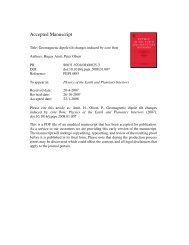For Peer Review Only - TARA
For Peer Review Only - TARA
For Peer Review Only - TARA
Create successful ePaper yourself
Turn your PDF publications into a flip-book with our unique Google optimized e-Paper software.
Page 15 of 69<br />
Molecular Physics<br />
1<br />
2<br />
3<br />
4<br />
5<br />
6<br />
7<br />
8<br />
9<br />
10<br />
11<br />
12<br />
13<br />
14<br />
15<br />
16<br />
17<br />
18<br />
19<br />
20<br />
21<br />
22<br />
23<br />
24<br />
25<br />
26<br />
27<br />
28<br />
29<br />
30<br />
31<br />
32<br />
33<br />
34<br />
35<br />
36<br />
37<br />
38<br />
39<br />
40<br />
41<br />
42<br />
43<br />
44<br />
45<br />
46<br />
47<br />
48<br />
49<br />
50<br />
51<br />
52<br />
53<br />
54<br />
55<br />
56<br />
57<br />
58<br />
59<br />
60<br />
fragments follows a mechanism slightly different with respect to that previously<br />
discussed for the trans complex. An additional, third phosphine ligand (not bound to<br />
palladium) is immediately involved, entering the system at this stage. The<br />
corresponding phosphorus atom P3 interacts with the two acetates. In particular the<br />
oxygen (O2) of one acetate is bridging the Pd and P3 atoms: the P3-O2 interaction is<br />
<strong>For</strong> <strong>Peer</strong> <strong>Review</strong> <strong>Only</strong><br />
already rather strong (2.130 Å) and the Pd-O2 bond remains significant (Pd-O2 =<br />
2.649 Å). Even the second oxygen of the same acetate (O1) considerably interacts<br />
with the phosphorus (P3-O1 = 2.572 Å). The second acetate fragment remains closer<br />
to the metal (Pd-O3) = 2.252 Å) and its interaction with the approaching phosphine is<br />
much weaker (P3-O2 = 2.941 Å). In summary, the incoming phosphine “captures” the<br />
two acetates helping their expulsion from the coordination sphere of the metal that<br />
retains the electrons of the Pd-OAc bonds, thus reducing its oxidation state. However,<br />
TS8 is characterized by a rather high energy barrier (41.8 kcal mol -1 in gas phase and<br />
52.2 kcal mol -1 in solvent) and lies 20.3 kcal mol -1 (19.7 kcal mol -1 at the PCM level)<br />
above the highest transition state located along the trans pathway. Thus, the cis<br />
channel cannot effectively compete with the trans one and for this reason we do not<br />
discuss further.<br />
(Table 5 here)<br />
(Scheme 4 here)<br />
(Figure 3 here)<br />
The phosphorous species that forms after TS4 (PPh 3 (OAc) 2 ) easily converts<br />
into the corresponding phosphine oxide, which is detected experimentally at the end<br />
of the reaction, by reaction with one water molecule. The intermediates and transition<br />
states along this path are represented in Scheme 5, while the energy profile is<br />
URL: http://mc.manuscriptcentral.com/tandf/tmph
















